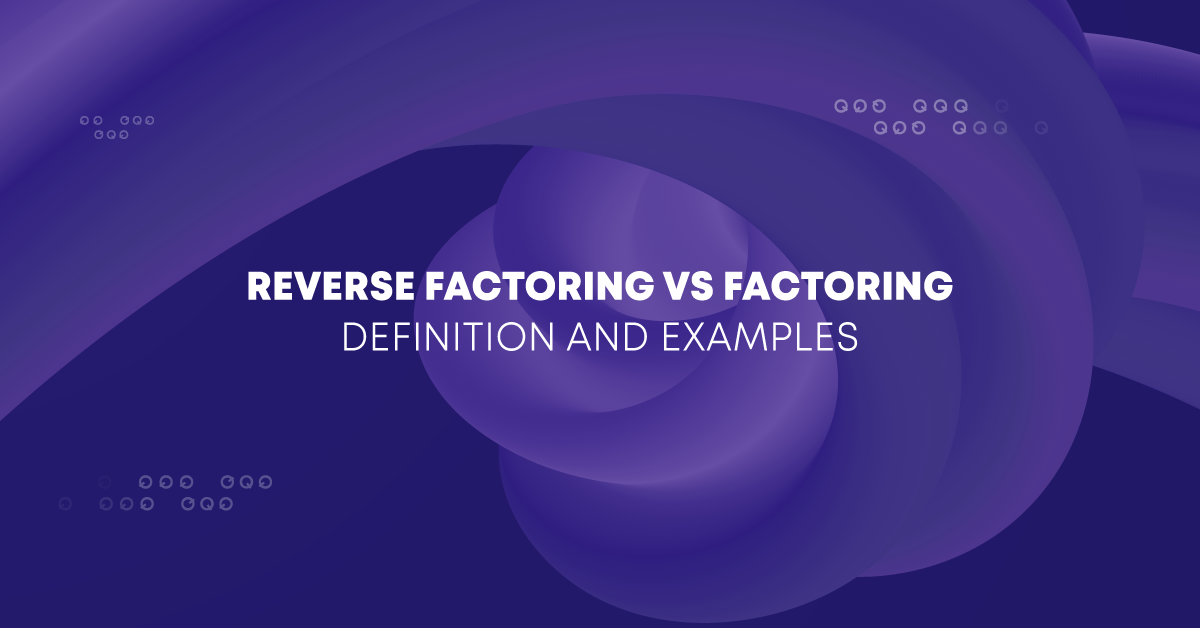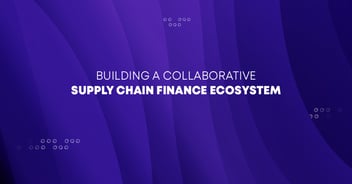Reverse Factoring VS Factoring Definition and Examples
QUALCO |
1. Introduction
Organisations use various solutions to enhance their operational efficiency, reduce expenses and optimise their cash flow. Two solutions commonly used for financial management are factoring and reverse factoring.
In this blogpost, we will explore what these solutions are, how they work, their benefits, their differences, and how you can execute them more efficiently with the use of factoring software.
2. What is Factoring?
Factoring is a financial solution that involves the cooperation of three parties: a buyer, supplier, and funder (factor).
.png?width=770&height=403&name=Reverse%20Factoring%20vs%20Factoring_schema%20(2).png)
The process is as follows:
- A seller sells goods or services and issues an invoice with a credit term to a buyer.
- The seller enters into an agreement with a funder to sell its outstanding invoices at a discount.
- The seller transfers its invoices to the funder and receives an advance, typically between 70% and 90% of the invoice value.
- The funder assumes the role of collecting payment from the buyer.
- After the buyer settles the payment, the funder subtracts its fees and transfers the residual amount to the seller.
Factoring can be a great way to streamline the supply chain. Suppliers can use it to speed up their cash flow and increase their working capital, which gives them access to more investment opportunities.
3. Reverse Factoring VS Factoring
Reverse factoring, otherwise, also known as “Supply chain finance” (SCF), involves the same parties as traditional factoring and follows an identical process. The core difference is that reverse factoring is set up by the buyer, instead of the supplier..png?width=739&height=387&name=Reverse%20Factoring%20vs%20Factoring_schema%20(1).png)
More specifically:
- The buyer purchases goods/services from the supplier.
- The buyer and supplier agree upon the terms of payment.
- The buyer arranges for extended payment terms with a funder.
- The supplier is given an opportunity to join the program and can voluntarily negotiate discount rates for early payment.
- When necessary, suppliers can request early payment from the funders.
- Funders receive the full payment amount from the buyer at the end of the agreed payment period.
Reverse Factoring streamlines the supply chain and minimises the time spent on invoice management for buyers. With this method, buyers can pay one source, the funder, instead of multiple suppliers.
4. A Practical Look at Factoring
Let’s break down how factoring works with a straightforward example. Suppose a supplier sells goods or services and issues an invoice for 1000 euros, due in 60 days. If the supplier needs cash sooner, they might approach a financial institution to factor the invoice.
After checking the buyer’s creditworthiness, the financial institution agrees to pay the supplier 900 euros right away in exchange for a 10% discount, planning to collect the full 1000 euros from the buyer later. This setup benefits everyone: the supplier gets quick cash, the financial institution makes a profit, and the buyer enjoys more time to pay.
5. Exploring Reverse Factoring
Reverse factoring comes into play when a large buyer wants to delay payments to their suppliers. The buyer sets up a finance program with a financial institution to extend the payment of their invoices.
Suppliers who join this program can get their money sooner, just like in regular factoring, but at a small cost. This way, reverse factoring also ends up helping all involved: suppliers get paid faster, buyers get more time, and financial institutions facilitate the process for a fee.
6. How you can Benefit from Them
Factoring and reverse factoring, while offering broadly similar advantages, provide distinct benefits tailored to the needs of funders, suppliers, and buyers. Here’s how each party stands to gain from these financial solutions:
For Funders
- Portfolio Diversification: Financial institutions can use factoring and reverse factoring to diversify their portfolios, thereby reducing risk and extracting valuable insights across a range of markets.
- Risk Mitigation: By having a varied client base, funders can spread and mitigate risks across multiple income sources.
- Enhanced Profitability: Financial institutions benefit from both arrangements through service fees or interest, bolstering their profitability.
For Suppliers
- Swift Cash Flow: Suppliers benefit from prompt payments, aiding significantly in liquidity and financial planning. The same benefit also applies to reverse factoring.
- Enhanced Growth Opportunities: Reliable cash flow from these arrangements opens up new investment prospects, enabling suppliers to undertake larger projects and expand their operational capacity.
- Competitive Interest Rates: Both factoring and reverse factoring typically offer more favourable interest rates than alternative financing options, easing the cost of borrowing.
For Buyers
- Extended Payment Terms: Buyers frequently secure more favourable payment timelines, especially in reverse factoring scenarios initiated by them, allowing for greater financial flexibility.
- Stronger Supplier Relations: Early and guaranteed payments under factoring/reverse factoring solidify buyer-supplier relationships, fostering mutual trust and cooperation.
- Supply Chain Efficiency: By ensuring timely payments and solidifying supplier relationships, factoring and reverse factoring contribute to a more efficient supply chain, minimizing disruptions and delays.
7. The Importance of Factoring Software
Factoring and reverse factoring require cooperation among several parties. That's where factoring software comes in to make processes quicker, efficient, and secure. Factoring software can help in the following ways:
- Streamlined Communication: Factoring software serves as a comprehensive hub, facilitating straightforward communication and collaboration among all parties with integrated messaging capabilities.
- Real Time Interaction: It ensures immediate access to updated transaction statuses for all stakeholders, maintaining transparency and keeping all parties informed on financing decisions in real time.
- Automated Processes: The software automates routine tasks, guiding each party through their required steps efficiently, ensuring a smooth progression of the factoring or reverse factoring processes.
- Risk Management: Equipped with advanced reporting tools and compliance checks, alongside sophisticated anti-fraud technologies, factoring software significantly reduces financial operation risks.
8. Choosing the Right Factoring Software: ProximaPlus
Choosing the correct factoring software is critical for the effective execution and management of your factoring and reverse factoring programs. QUALCO ProximaPlus stands out as a comprehensive solution, designed to meet the needs of modern financial operations with its array of features:
- Streamlined Operations: Enhance productivity and competitive advantage with a platform designed for the swift implementation of new factoring products and efficient operational management.
- Customisable User Interface: Tailor the platform's front end to meet specific user needs, ensuring smooth interaction and enhanced efficiency.
- Advanced Security Measures: With state-of-the-art security, including GDPR compliance and advanced tokenization, ProximaPlus safeguards sensitive data while ensuring legal compliance.
- Flexible Deployment Options: Adapt to your business's unique needs with various installation methods, including cloud-based solutions and on-premise installations.
- Real-Time Interaction: Facilitate immediate, transparent access to transaction statuses and actions, promoting dynamic management and customer engagement.
ProximaPlus by QUALCO is a strategic asset for businesses looking to navigate the complexities of receivables finance with ease. It sets new standards in operational efficiency and client satisfaction, making it the go-to solution for factoring and reverse factoring needs. Discover the transformative impact of ProximaPlus on your financial operations.



.png?width=352&name=Artboard%202%20copy%204%20(1).png)
